Overview
The article asserts that local energy market wind integration presents significant advantages, including economic growth, job creation, environmental sustainability, and enhanced energy reliability. These advantages are substantiated by evidence illustrating:
- Substantial financial contributions to local economies
- Increased employment opportunities
- Reduced carbon emissions
- Improved grid stability
This compelling evidence makes a strong case for the adoption of wind energy initiatives.
Introduction
The transition to renewable energy serves not merely as an environmental necessity; it acts as a powerful catalyst for economic revitalization and community empowerment. Local energy market wind integration presents a multitude of benefits that extend well beyond the mere generation of clean power. These benefits include:
- Significant job creation
- Enhanced economic stability
- A marked reduction in carbon footprints
However, as regions endeavor to harness this potential, they encounter substantial challenges, particularly in land acquisition and regulatory navigation. How can communities effectively capitalize on the advantages of wind energy while surmounting these obstacles to secure a sustainable and prosperous future?
Harbinger Land | Comprehensive Solutions for Land Acquisition in Wind Energy Projects
In the realm of renewable power initiatives, land acquisition poses significant challenges. Harbinger Land stands at the forefront, delivering comprehensive solutions tailored to these complexities. Their offerings encompass:
- Site and right-of-way acquisition
- Title research
- GIS mapping
- Data processing
All critical components in the successful execution of renewable projects.
Navigating the intricate legal and regulatory landscape can be daunting. Harbinger Land's veteran team is well-versed in these complexities, ensuring clients receive services that are not only effective but also customized to meet their unique needs. By leveraging advanced technology, including AI-powered title research software, they enhance both efficiency and accuracy in the land acquisition process.
The importance of prompt and precise land access cannot be overstated in the renewable sector. With Harbinger Land, clients gain a partner committed to overcoming obstacles, ensuring a seamless acquisition experience. Their expertise translates into tangible benefits, enabling clients to focus on their core initiatives while leaving the intricacies of land acquisition in capable hands.
Are you ready to navigate the complexities of land acquisition with confidence? Partner with Harbinger Land to ensure your renewable power projects succeed. Contact us today to learn how we can assist you in achieving your goals.
Economic Growth: Boosting Local Economies Through Wind Energy Integration
Incorporating wind energy into regional economies through local energy market wind integration presents a significant opportunity for economic growth. Wind initiatives generate approximately $2 billion annually through regional tax contributions and land-lease contracts, providing a vital income source for communities. This financial influx can be reinvested into essential services, infrastructure enhancements, and local businesses, creating a positive feedback loop that bolsters overall economic vitality.
Moreover, the establishment and ongoing maintenance of renewable energy farms are essential for local energy market wind integration and lead to the creation of numerous job openings. Research indicates an employment increase of around 0.4% within a 20-mile radius of active energy initiatives, equating to approximately 230 positions over the lifespan of these projects. Such developments not only stimulate regional economies but also support local energy market wind integration, contributing to an average income rise of 4% for local employees, which translates into an additional $1,270 each year.
The long-term advantages of integrating renewable power are evident, as these economic impacts persist for six years post-completion. This underscores the importance of renewable sources in promoting sustainable regional growth. As highlighted by the Lawrence Berkeley National Lab, these outcomes can be viewed as spillover benefits stemming from increased local tax and lease income generated by renewable energy projects.
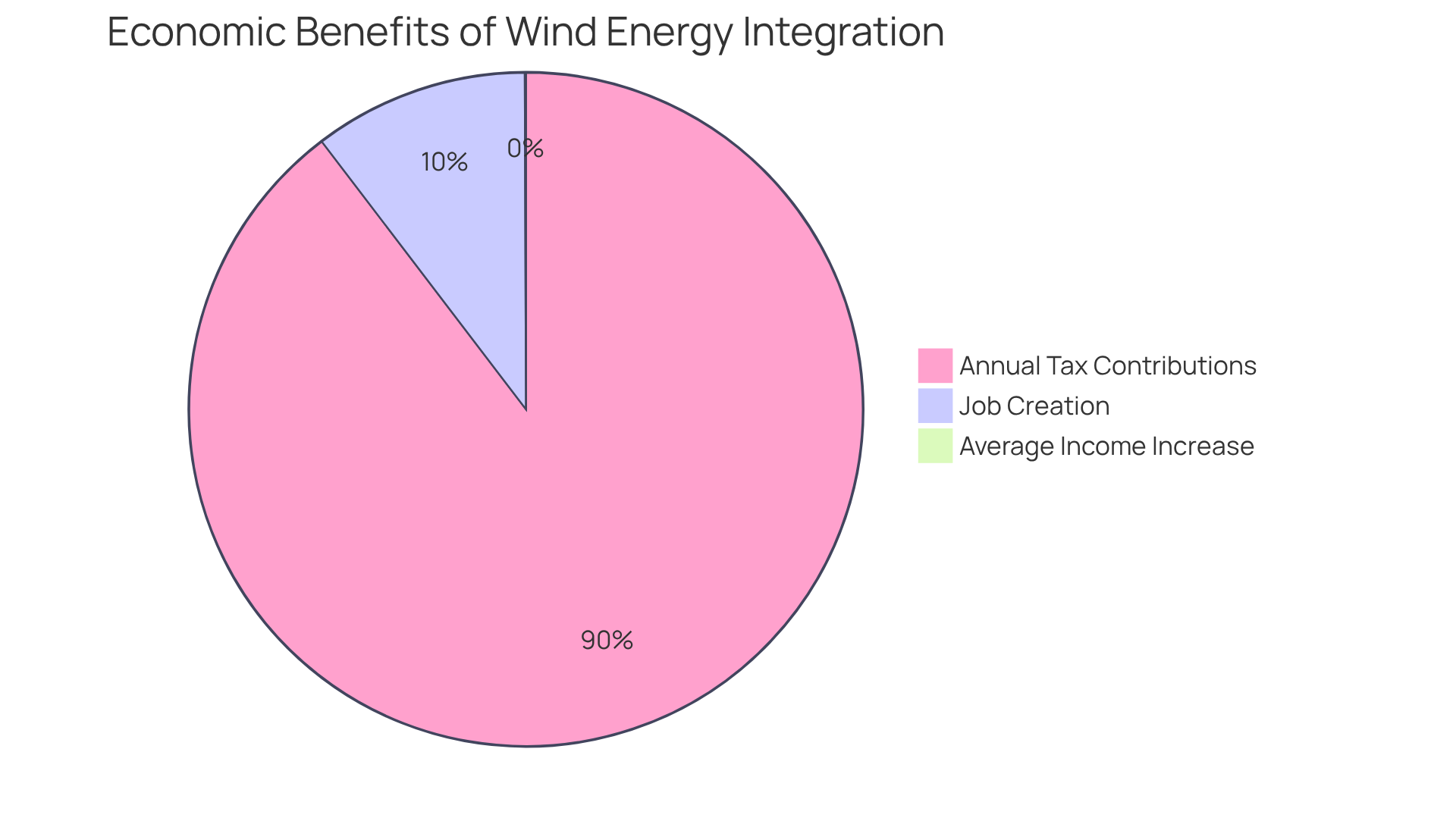
Environmental Sustainability: Reducing Carbon Footprint with Wind Energy
Wind power stands as a cornerstone of environmental sustainability, effectively reducing the carbon footprint linked to electricity generation. By replacing fossil fuels with clean energy derived from air currents, communities have the potential to avert millions of metric tons of CO2 emissions annually. This transition not only addresses climate change but also fosters cleaner air and healthier ecosystems. As further renewable projects are initiated, the cumulative environmental benefits will contribute to the realization of a more sustainable future.
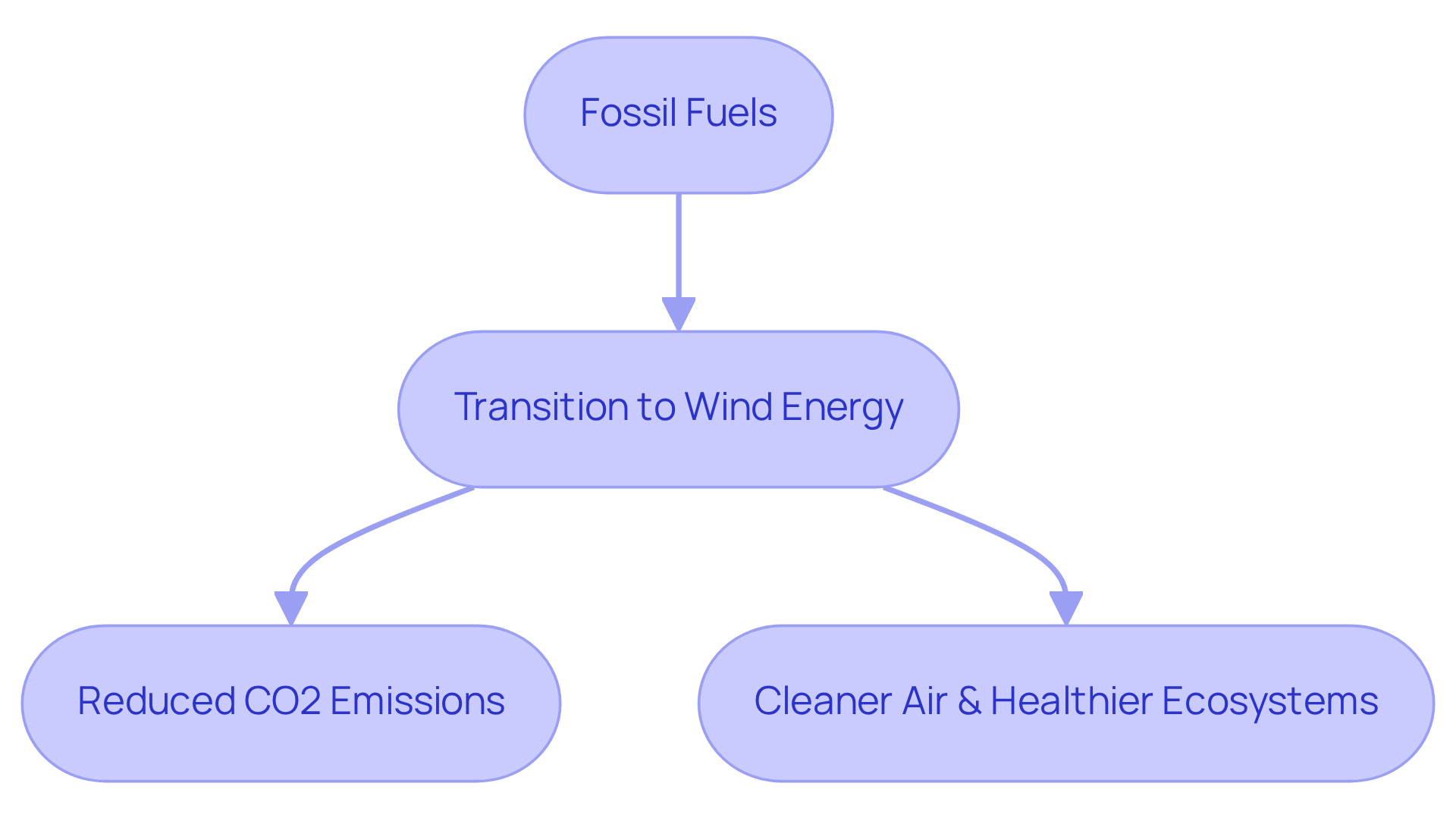
Energy Reliability: Enhancing Grid Stability with Wind Power
Incorporating wind power into the power grid significantly enhances overall reliability and stability. Wind energy serves as a crucial component of a diverse power mix, effectively reducing reliance on any single source of electricity. By leveraging advanced prediction and grid control technologies, utilities can enhance their capability to anticipate and manage the fluctuations associated with wind power. This ensures a consistent and reliable electricity supply.
As the demand for renewable resources continues to rise, the need for innovative solutions to maintain grid stability becomes increasingly important. The complexities involved in local energy market wind integration, including the legal and regulatory challenges of land acquisition, highlight the necessity for effective strategies. Utilities that embrace these advancements not only contribute to a sustainable energy future but also position themselves as leaders in the evolving energy landscape.
By understanding the dynamics of wind energy and implementing robust management practices, stakeholders can navigate the complexities of local energy market wind integration during the energy transition. This proactive approach not only secures grid reliability but also fosters a resilient energy infrastructure.
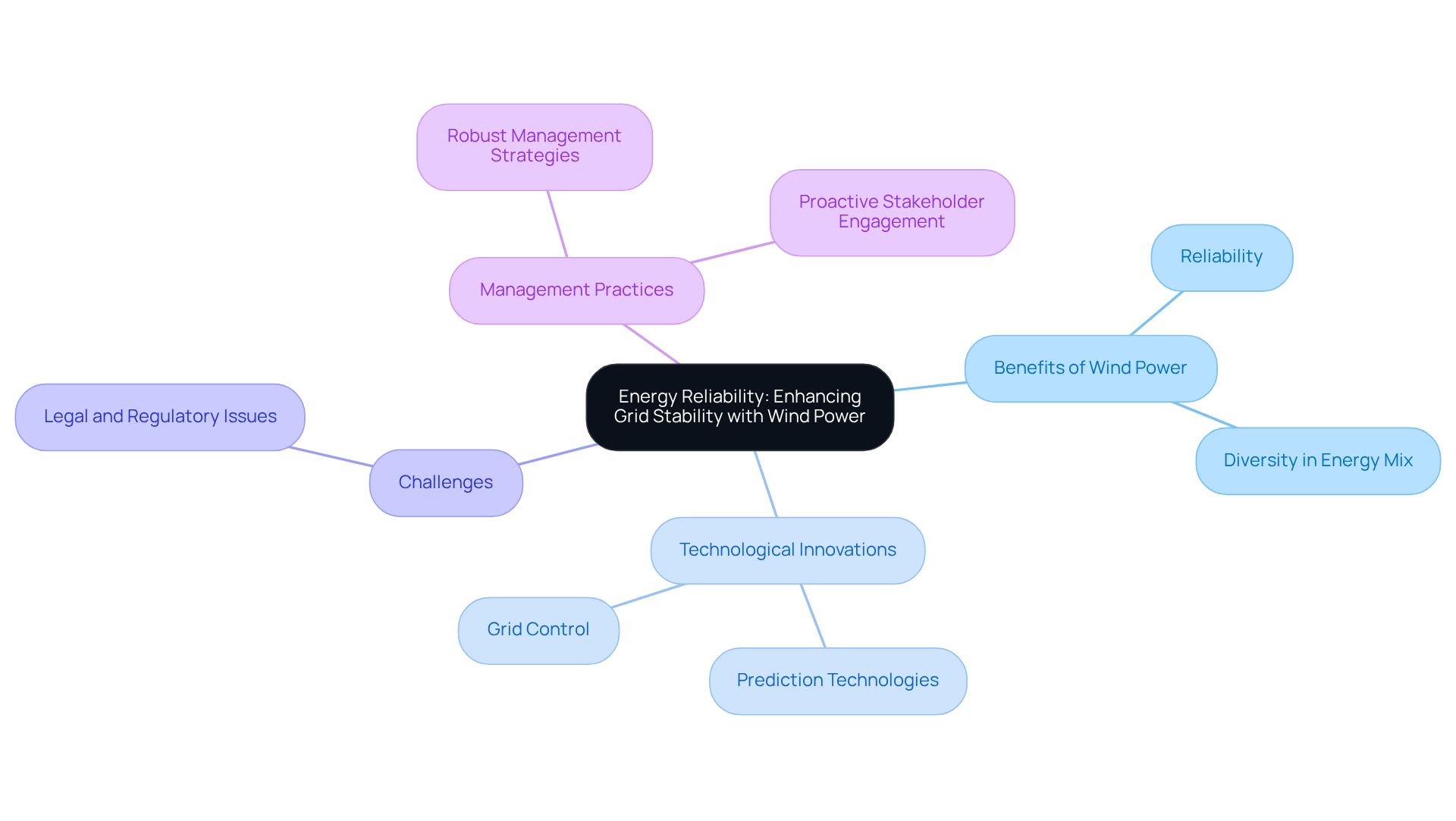
Technological Innovation: Advancements in Wind Energy Integration
Technological advancement is pivotal for local energy market wind integration of renewable resources into the power grid. Innovations in turbine design, power storage solutions, and grid management systems have significantly enhanced the efficiency and reliability of renewable energy sources. For instance, larger and more efficient turbines now capture increased power from the atmosphere, while smart grid technologies streamline the management of power distribution.
In 2022, turbine systems generated over 10% of the U.S. power supply, contributing $20 billion to the economy. The renewable energy sector currently supports nearly 150,000 jobs nationwide, with job growth expected to continue. These advancements not only boost the efficiency of renewable power initiatives but also reduce costs, making local energy market wind integration a more attractive energy source for service providers.
However, it is crucial to recognize that wind energy projects may struggle to be cost-competitive in areas lacking sufficient wind resources. Additionally, enhancing the national transmission system could significantly reduce the costs associated with expanding land-based renewable energy, further supporting the sector's growth.
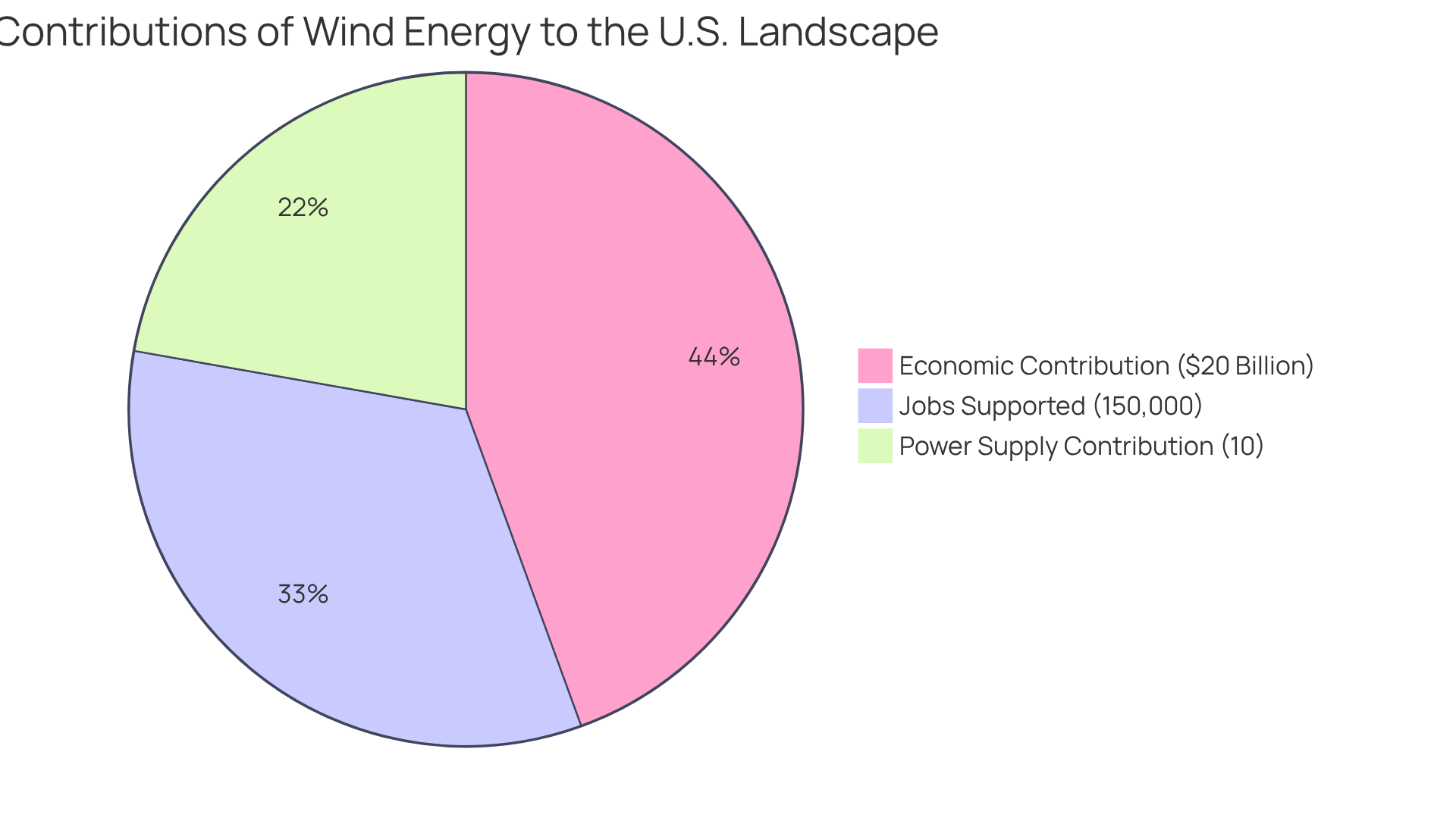
Job Creation: Generating Employment Opportunities Through Wind Energy
Wind energy initiatives represent a crucial avenue for job creation, delivering employment opportunities across diverse sectors. From construction and installation to maintenance and operations, the renewable energy sector underpins a wide array of jobs. Recent studies indicate that the development of onshore energy projects can lead to a regional employment increase of approximately 0.4%, translating to hundreds of jobs generated around energy farms. This job creation not only enhances individual livelihoods but also fortifies regional economies by boosting disposable income and supporting local businesses.
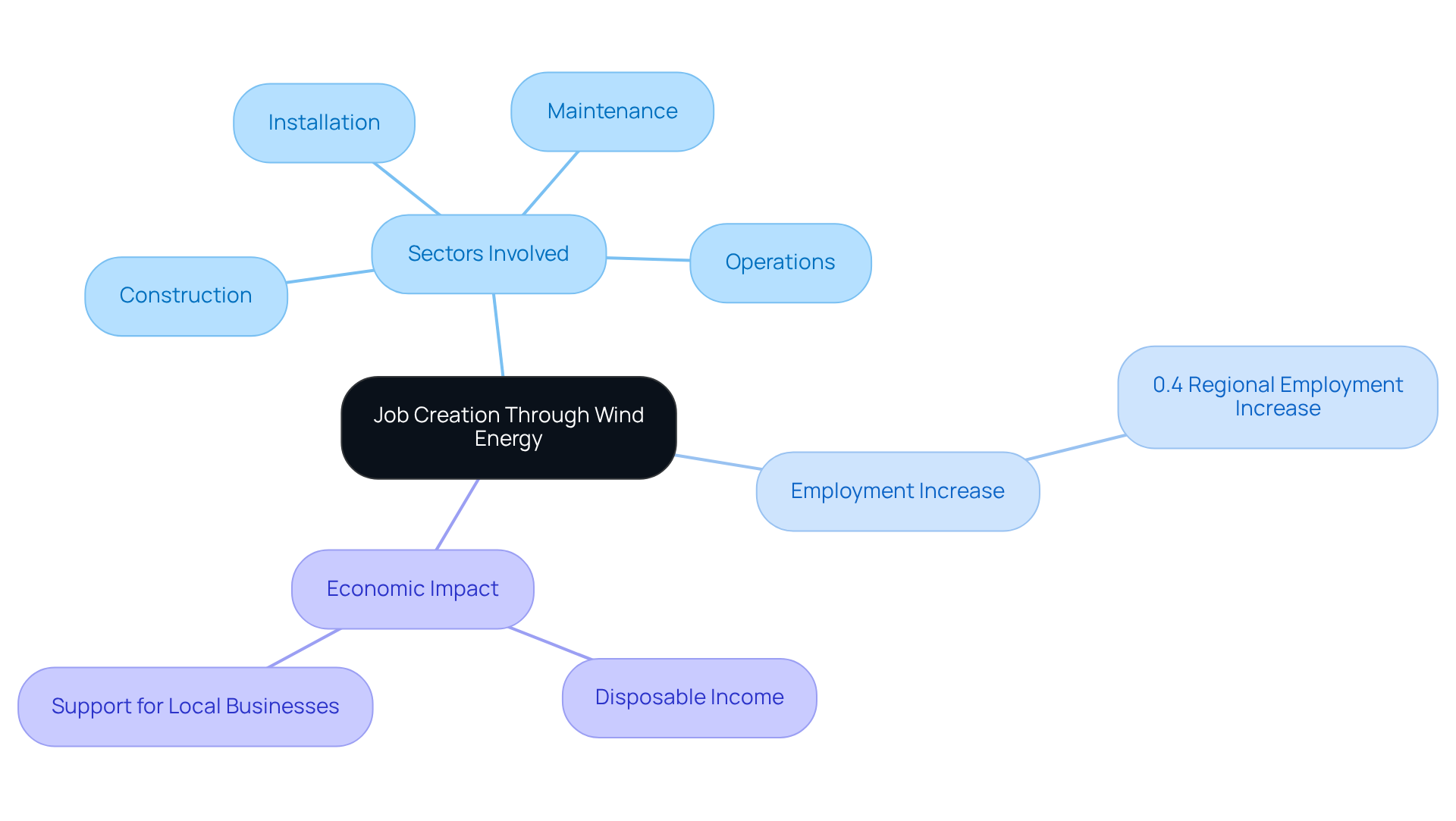
Community Engagement: Building Local Support for Wind Energy Initiatives
Effective community involvement is crucial for the success of energy initiatives. By engaging nearby residents in planning and decision-making, trust is built and concerns regarding wind initiatives are addressed. Strategies such as hosting informational meetings and maintaining transparent communication about project impacts are vital.
Establishing community benefits agreements ensures that local stakeholders receive tangible advantages, including financial compensation and infrastructure improvements. For instance, in Denmark, over 150,000 households were financially engaged in energy farms by 2001, demonstrating the positive impact of community participation. Additionally, compulsory payments of €1000 each year are allocated from community benefit funds for residents within 1 km of an initiative, further illustrating the financial implications of community engagement.
Involving the community cultivates a sense of ownership and significantly boosts support for local energy market wind integration, which is essential for their long-term sustainability. Statistics indicate that projects with robust community engagement strategies achieve greater success rates, emphasizing the necessity for developers to prioritize community involvement.
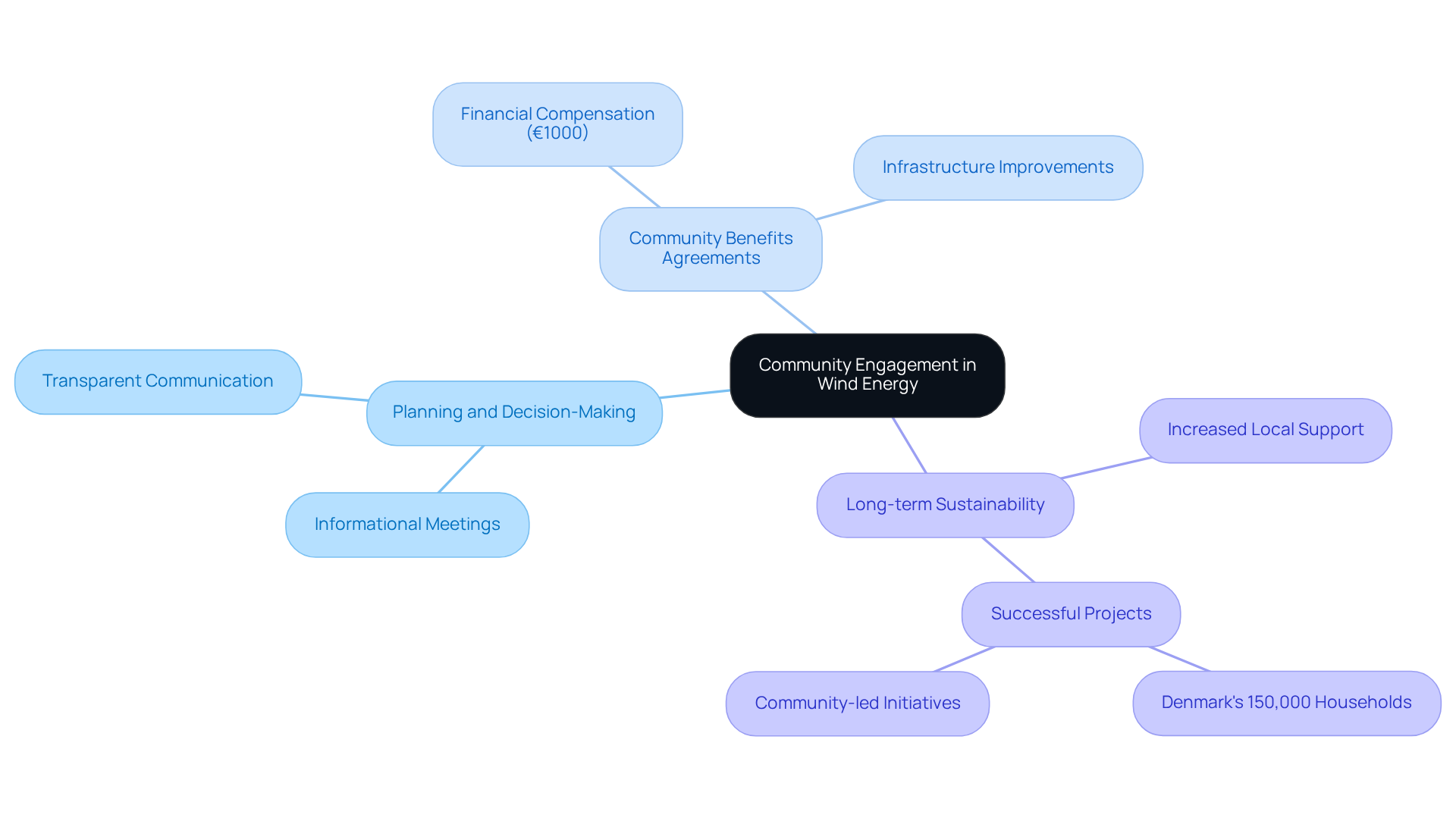
Energy Independence: Achieving Self-Sufficiency with Wind Power
Local energy market wind integration is essential for achieving resource independence in communities and regions. By harnessing local air resources through local energy market wind integration, these areas can significantly reduce their reliance on imported fossil fuels, thereby enhancing their energy security. This self-sufficiency not only stabilizes energy prices but also shields communities from the volatility of global energy markets. As more regions invest in renewable energy infrastructure, the potential for local energy market wind integration expands, paving the way for a more resilient and sustainable energy future.
Consider the complexities involved in transitioning to renewable energy. Legal and regulatory challenges can impede progress, yet the rewards of investing in local resources are undeniable. Communities that embrace local energy market wind integration can foster economic growth while ensuring a stable energy supply.
In conclusion, the path to energy independence is clear. By prioritizing wind power, communities can secure their future against the uncertainties of the global energy landscape. It is time to take action and invest in renewable energy solutions that benefit both the environment and the economy.
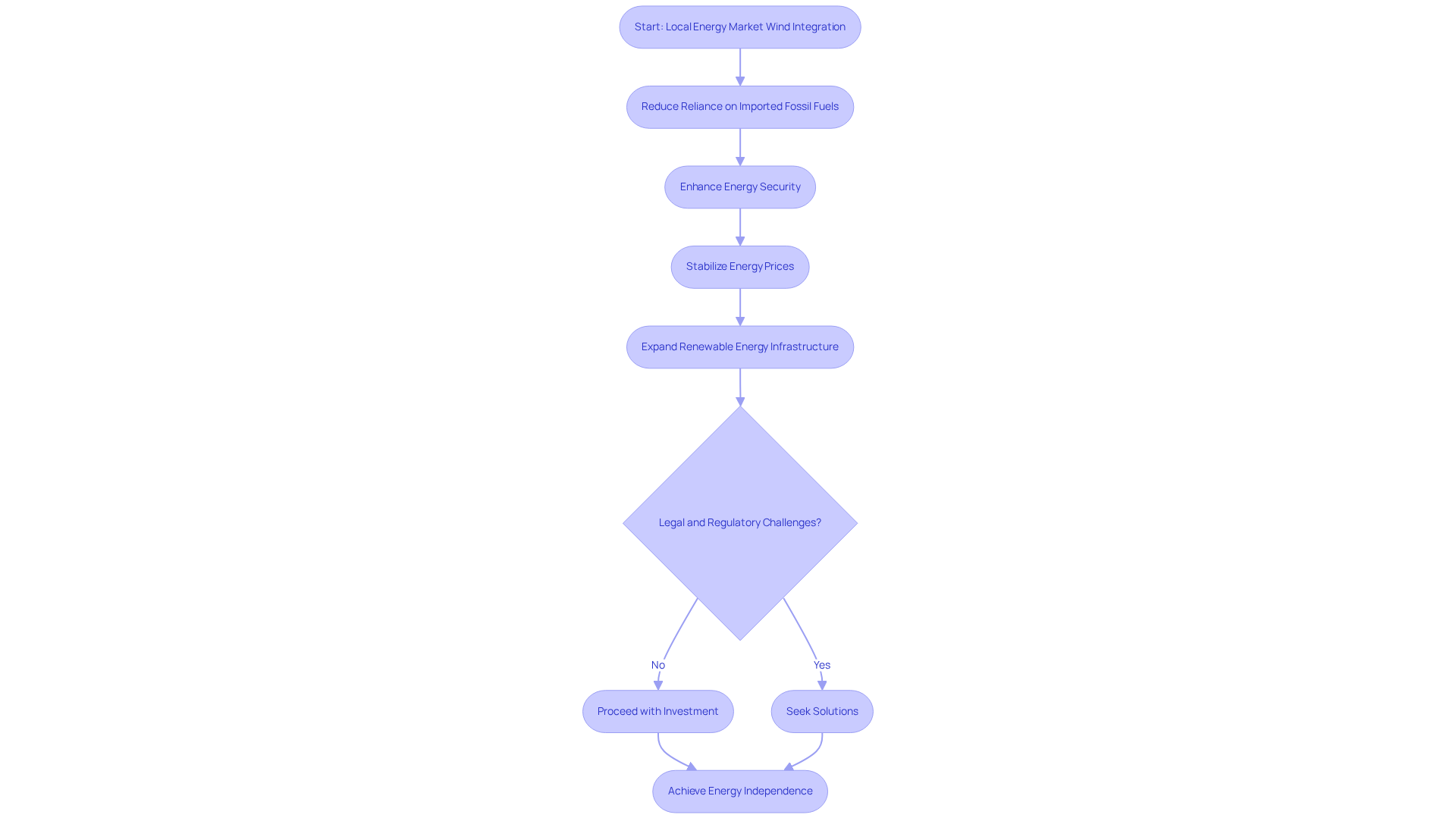
Regulatory Benefits: Navigating Local Policies for Wind Energy Development
Navigating the regulatory landscape is crucial for successful renewable energy development. Local policies present substantial benefits, including tax incentives that enhance feasibility and profitability. For instance, energy initiatives contributed over $2 billion in state and local tax contributions and land-lease payments last year, highlighting the economic advantages of local policies.
Tax incentives have proven to stimulate investment in wind initiatives, with the U.S. wind sector attracting nearly $330 billion in investments over the past twenty years. Furthermore, streamlined permitting procedures expedite timelines, allowing developers to capitalize on favorable market conditions.
Engaging with regional authorities and stakeholders not only facilitates smoother approvals but also fosters positive relationships that can support future initiatives. Legal experts emphasize that understanding regional policies is vital for maximizing these benefits, as favorable regulations can significantly impact the feasibility and success of renewable projects.
A case study from a region with proactive policies illustrates accelerated renewable power development, showcasing the tangible benefits of community involvement and regulatory support.
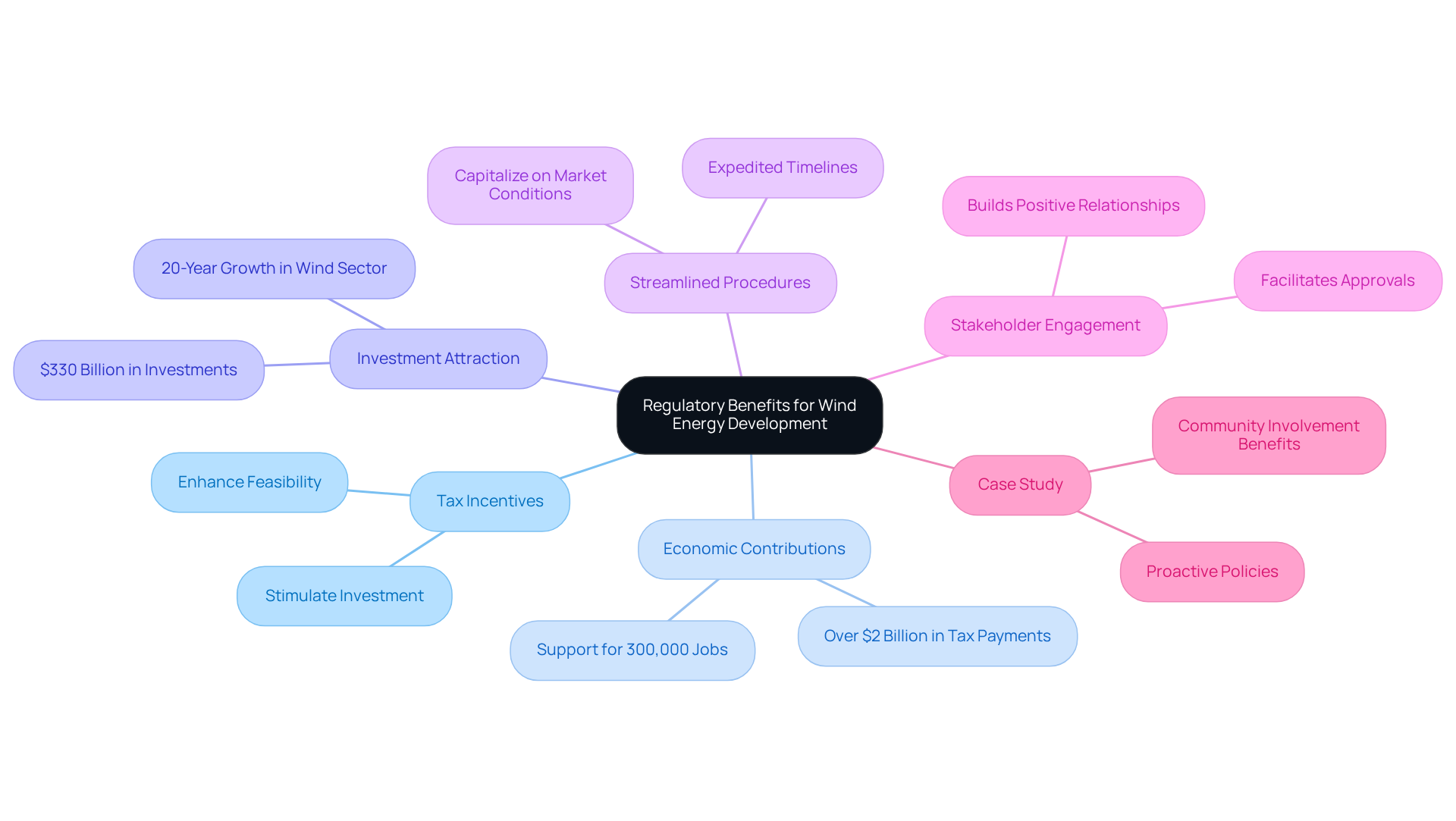
Comprehensive Advantages: The Multifaceted Benefits of Wind Energy Integration
The incorporation of renewable resources presents a compelling case that extends beyond mere ecological sustainability. It not only strengthens local economies and generates jobs but also enhances power reliability and promotes resource independence. These factors collectively make a persuasive argument for investment in renewable power. Moreover, ongoing technological advancements continue to boost the efficiency and effectiveness of turbine projects, making them increasingly viable options for meeting energy demands. By recognizing and capitalizing on these multifaceted advantages, stakeholders can make informed decisions that foster the growth of wind energy initiatives.
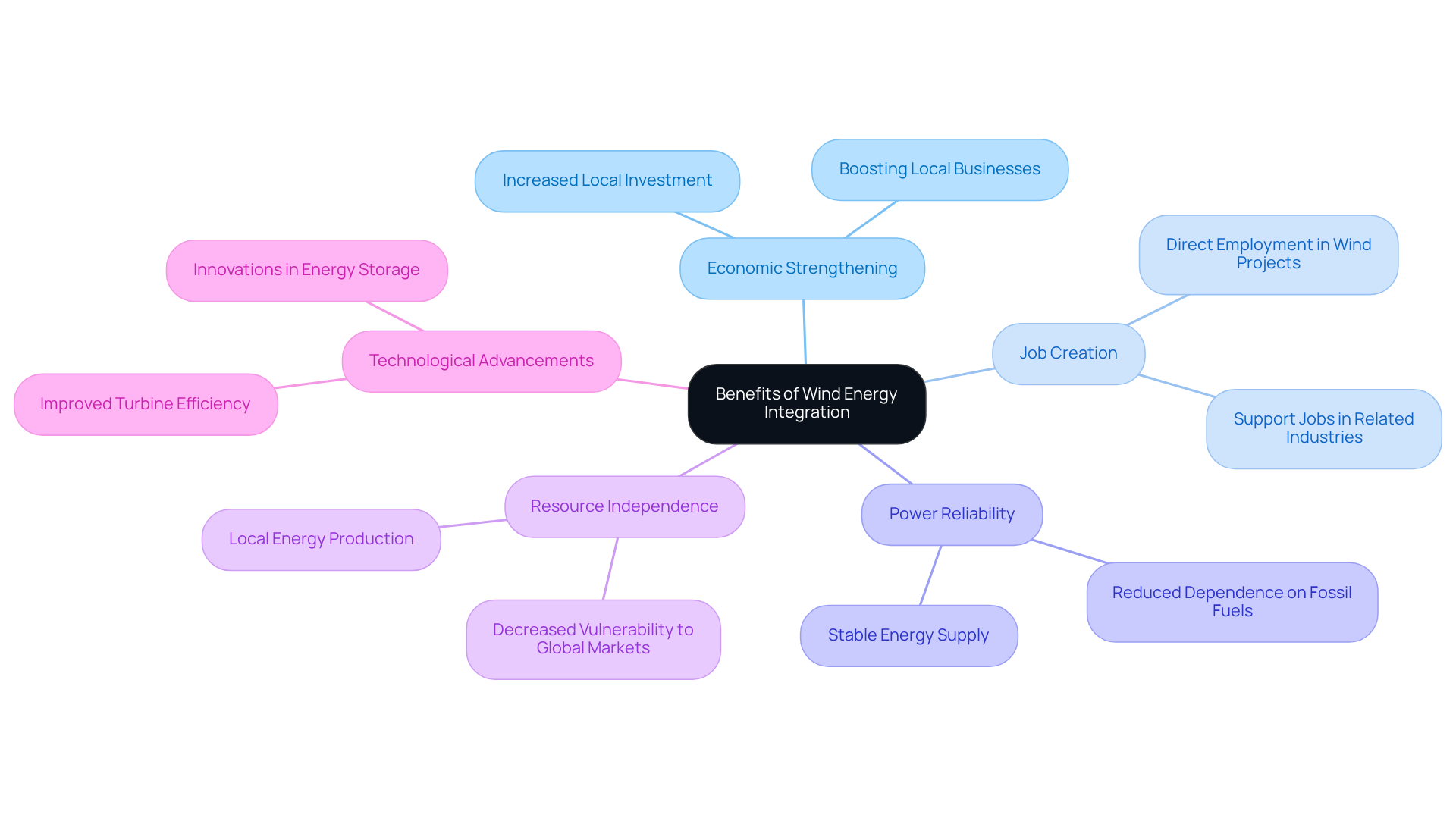
Conclusion
Integrating wind energy into local energy markets presents a wealth of advantages that extend well beyond simple electricity generation. This strategy not only stimulates economic growth and job creation but also bolsters environmental sustainability and energy reliability. By prioritizing wind power, communities can leverage local resources to attain energy independence, laying the groundwork for a more resilient and sustainable future.
The article emphasizes several key benefits, including:
- The substantial economic contributions of wind energy through tax revenues and job opportunities
- The reduction of carbon footprints
- Advancements in technology that enhance the efficiency of wind power systems
Furthermore, effective community engagement and navigating regulatory landscapes are vital for the successful implementation of wind energy projects, ensuring that local stakeholders are actively involved and supported throughout the process.
As the world transitions towards renewable energy solutions, the significance of integrating wind energy into local markets cannot be overstated. Communities are urged to embrace these initiatives, not only for their immediate advantages but also for the enduring positive impacts on local economies, the environment, and energy security. Investing in wind energy is not merely a step towards sustainability; it is a commitment to cultivating a thriving future for generations to come.
Frequently Asked Questions
What services does Harbinger Land provide for land acquisition in wind energy projects?
Harbinger Land offers comprehensive solutions including site and right-of-way acquisition, title research, GIS mapping, and data processing.
How does Harbinger Land ensure effective land acquisition?
Their veteran team is experienced in navigating legal and regulatory complexities, providing customized services. They also utilize advanced technology, such as AI-powered title research software, to enhance efficiency and accuracy.
Why is prompt land access important in renewable energy projects?
Prompt and precise land access is crucial for the successful execution of renewable projects, allowing clients to focus on their core initiatives without the burden of land acquisition intricacies.
What economic benefits does wind energy integration provide to local communities?
Wind energy initiatives generate approximately $2 billion annually through regional tax contributions and land-lease contracts, which can be reinvested into essential services and local businesses, boosting overall economic vitality.
How does wind energy impact employment in local areas?
The establishment and maintenance of renewable energy farms can increase employment by about 0.4% within a 20-mile radius of energy initiatives, creating approximately 230 jobs over the lifespan of these projects.
What is the long-term economic impact of integrating renewable energy?
The economic benefits of renewable energy projects can persist for six years post-completion, contributing to an average income rise of 4% for local employees, equating to an additional $1,270 each year.
How does wind energy contribute to environmental sustainability?
Wind power reduces the carbon footprint associated with electricity generation by replacing fossil fuels with clean energy, potentially averting millions of metric tons of CO2 emissions annually and fostering cleaner air and healthier ecosystems.
List of Sources
- Economic Growth: Boosting Local Economies Through Wind Energy Integration
- Do large-scale wind projects increase local employment? New US study says yes, and those effects last. | Energy Markets & Policy (https://emp.lbl.gov/news/do-large-scale-wind-projects-increase-local-employment-new-us-study-says-yes-and-those)
- Advantages and Challenges of Wind Energy (https://energy.gov/eere/wind/advantages-and-challenges-wind-energy)
- Technological Innovation: Advancements in Wind Energy Integration
- Advantages and Challenges of Wind Energy (https://energy.gov/eere/wind/advantages-and-challenges-wind-energy)
- Community Engagement: Building Local Support for Wind Energy Initiatives
- WINDExchange: Wind Energy's Economic Impacts to Communities (https://windexchange.energy.gov/projects/economic-impacts)
- Price or public participation? Community benefits for onshore wind in Ireland, Denmark, Germany and the United Kingdom (https://sciencedirect.com/science/article/pii/S2214629624001968)
- Regulatory Benefits: Navigating Local Policies for Wind Energy Development
- Wind Power Facts and Statistics | ACP (https://cleanpower.org/facts/wind-power)
- css.umich.edu (https://css.umich.edu/publications/factsheets/energy/us-renewable-energy-factsheet)




